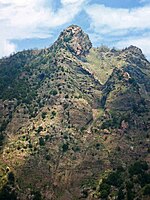Mount Somma
Calderas of ItalyGeological type localitiesMount VesuviusMountains of CampaniaStratovolcanoes of Italy ... and 2 more
VEI-6 volcanoesVolcanoes of Italy

Mount Somma (Italian: Monte Somma, lit. 'Mount Summit') is a mountain located in the Province of Naples, in the Campania region of southern Italy. It is 1,132 metres (3,714 ft) high. It is an integral part of the Somma–Vesuvius volcanic complex and of the larger Campanian volcanic arc, which is known for its high levels of seismic and volcanic activity. The volcano is believed to have formed over 25,000 years ago. It has a collapsed caldera of an older volcano, with Mount Vesuvius rising up from the center. Despite the potential dangers associated with living near an active volcano, the Somma volcano and its surroundings are a popular tourist destination.
Excerpt from the Wikipedia article Mount Somma (License: CC BY-SA 3.0, Authors, Images).Mount Somma
Sentiero del Grande Cono,
Geographical coordinates (GPS) Address Nearby Places Show on map
Geographical coordinates (GPS)
| Latitude | Longitude |
|---|---|
| N 40.821666666667 ° | E 14.426111111111 ° |
Address
Sentiero del Grande Cono
80040
Campania, Italy
Open on Google Maps










